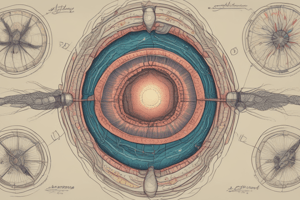Podcast
Questions and Answers
What is the role of rhabditiform larvae in the life cycle of Ancylostoma duodenale?
What is the role of rhabditiform larvae in the life cycle of Ancylostoma duodenale?
- They mature into adult worms in the small intestine.
- They develop into infective filariform larvae. (correct)
- They migrate through the bloodstream to the lungs.
- They are the eggs released in feces.
Which symptom is specifically associated with the intestinal effects of Ancylostoma duodenale infection?
Which symptom is specifically associated with the intestinal effects of Ancylostoma duodenale infection?
- Coughing and respiratory issues.
- Localized itching at infection site.
- Iron deficiency anemia. (correct)
- Skin rash.
What laboratory test is primarily used for diagnosing Ancylostoma duodenale infection?
What laboratory test is primarily used for diagnosing Ancylostoma duodenale infection?
- Skin scraping analysis.
- Blood tests for dehydration.
- Imaging studies to observe the intestinal tract.
- Stool examination for the detection of eggs. (correct)
Which medication is NOT commonly used for treating Ancylostoma duodenale infection?
Which medication is NOT commonly used for treating Ancylostoma duodenale infection?
What is one of the key prevention methods for Ancylostoma duodenale infection?
What is one of the key prevention methods for Ancylostoma duodenale infection?
Which factor does NOT influence the severity of Ancylostoma duodenale infection?
Which factor does NOT influence the severity of Ancylostoma duodenale infection?
What is the primary cause of localized inflammation associated with Ancylostoma duodenale infection?
What is the primary cause of localized inflammation associated with Ancylostoma duodenale infection?
What dietary adjustment is recommended for managing anemia due to Ancylostoma duodenale infection?
What dietary adjustment is recommended for managing anemia due to Ancylostoma duodenale infection?
Flashcards are hidden until you start studying
Study Notes
Ancylostoma duodenale Study Notes
Life Cycle
- Adult Stage: Lives in the small intestine of humans; females produce eggs.
- Eggs: Released in feces; develop into larvae in the soil.
- Larval Stages:
- Rhabditiform larvae: Free-living stage, can develop into infective filariform larvae.
- Filariform larvae: Infective stage, can penetrate skin or be ingested.
- Infection:
- Skin penetration: Larvae enter through intact skin (usually feet).
- Oral ingestion: Less common but possible.
- Migration:
- Larvae migrate through the bloodstream to the lungs, ascend the respiratory tract, and are swallowed.
- Maturation: Reach the small intestine, where they mature into adults.
Pathogenesis
- Infection Mechanism:
- Larvae penetrate skin, causing localized inflammation and itching (ground itch).
- Intestinal Effects:
- Attach to intestinal mucosa, leading to blood loss and potential anemia.
- Can cause protein malnutrition.
- Symptoms:
- Abdominal pain, diarrhea, weight loss, fatigue, and iron deficiency anemia.
- Severity: Depends on the number of worms and host health.
Diagnosis
- Clinical Assessment:
- Consider symptoms and exposure history.
- Laboratory Tests:
- Stool examination: Detect eggs in feces.
- Blood tests: Check for anemia or eosinophilia.
- Imaging: Rarely required, but may be used to assess complications.
Treatment Options
- Medications:
- Albendazole: Commonly used, effective against adult worms.
- Mebendazole: Another effective option.
- Pyrantel pamoate: Alternative, especially in children.
- Anemia Management:
- Iron supplementation and dietary adjustments as needed.
Prevention Methods
- Hygiene Practices:
- Proper sanitation; avoid fecal contamination of soil.
- Footwear:
- Wear shoes in endemic areas to prevent skin penetration.
- Public Health Measures:
- Education about transmission and hygiene.
- Regular deworming programs in high-prevalence areas.
Life Cycle
- Adults inhabit the small intestine of humans; females produce eggs that are released in feces.
- Eggs develop into larvae within the soil after excretion.
- Rhabditiform larvae are the free-living stage capable of developing into infective filariform larvae.
- Filariform larvae represent the infective stage, able to penetrate human skin or be ingested.
- Infection methods include skin penetration, primarily through the feet, or, less commonly, oral ingestion.
- Migration process: Larvae travel through the bloodstream to the lungs, ascend the respiratory tract, and are subsequently swallowed.
- Once swallowed, larvae mature into adults in the small intestine.
Pathogenesis
- Infection initiation occurs as larvae penetrate the skin, leading to localized inflammation and itching known as ground itch.
- In the intestines, larvae attach to the mucosa, resulting in blood loss and potential anemia, along with protein malnutrition.
- Common symptoms include abdominal pain, diarrhea, weight loss, fatigue, and iron deficiency anemia.
- The severity of symptoms correlates with the worm load and overall health of the host.
Diagnosis
- Clinical assessment should involve evaluating symptoms alongside exposure history.
- Laboratory tests are essential, including stool examinations to detect eggs and blood tests to assess for anemia or eosinophilia.
- Imaging is typically unnecessary but may be used to identify complications related to the infection.
Treatment Options
- Albendazole is commonly prescribed, effectively targeting adult worms.
- Mebendazole serves as another effective treatment option.
- Pyrantel pamoate is an alternative, particularly suitable for children.
- Management of anemia requires iron supplementation and necessary dietary modifications.
Prevention Methods
- Hygiene practices crucial for prevention include maintaining proper sanitation and avoiding fecal contamination of soil.
- Wearing footwear in endemic areas significantly reduces the risk of skin penetration by larvae.
- Public health measures emphasize education on transmission and hygiene, alongside regular deworming programs in regions with high prevalence.
Studying That Suits You
Use AI to generate personalized quizzes and flashcards to suit your learning preferences.




